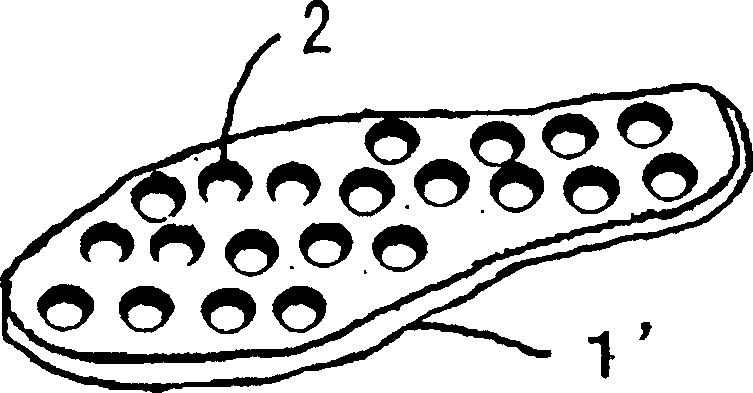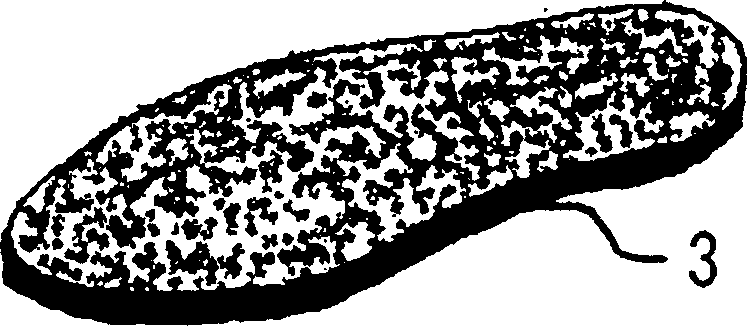Middle sole and its production process and shoes with the middle sole
A manufacturing method and square technology, applied in the field of shoe midsoles, can solve the problems of not feeling high-grade, not light, heavy materials, etc., and achieve the effects of excellent shoe midsoles, long life and less adverse effects
- Summary
- Abstract
- Description
- Claims
- Application Information
AI Technical Summary
Problems solved by technology
Method used
Image
Examples
Embodiment 1
[0082] figure 1 An example of the shoe midsole of the present invention is shown.
[0083] A shoe midsole made of CRB ceramics was fabricated as follows.
[0084] (Production of CRB ceramic front skeleton)
[0085] 75 kg of defatted rice bran obtained from rice bran and 25 kg of liquid phenolic resin (resol resin) were mixed and kneaded while being heated to 50 to 60°C. A homogeneous mixture with plasticity can be obtained.
[0086] The mixture was once fired at 900° C. for 60 minutes in a nitrogen atmosphere using a rotary furnace. Next, the obtained carbonized fired product was sieved through a 100-mesh sieve to obtain carbonized powder with a particle diameter of 50 to 250 μm.
[0087] 75 kg of the obtained carbonized powder and 25 kg of solid phenolic resin (resole resin) were mixed and kneaded while being heated to 100 to 150°C. Plastics of CRB ceramic pre-skeletons can be obtained as homogeneous mixtures with plasticity.
[0088] (Forming of shoe midsole)
[0089]...
Embodiment 2
[0098] (Production of CRB ceramic front skeleton)
[0099] 75 kg of defatted rice bran obtained from rice bran and 25 kg of liquid phenolic resin (resol resin) were mixed and kneaded while being heated to 50 to 60°C. A homogeneous mixture with plasticity can be obtained.
[0100] The mixture was once fired at 900° C. for 60 minutes in a nitrogen atmosphere using a rotary furnace. Next, the obtained carbonized fired product was sieved through a 100-mesh sieve to obtain carbonized powder with a particle diameter of 50 to 250 μm.
[0101] 75 kg of the obtained carbonized powder and 25 kg of solid phenolic resin (resole resin) were mixed and kneaded while being heated to 100 to 150°C. The CRB ceramic pre-skeleton can be obtained as a homogeneous mixture with plasticity.
[0102] (Forming of shoe midsole)
[0103] Next, put Figure 4 The skeleton 1 ' of the foot-shaped plate-like body that shows hole 2 is made of aluminum is put into metal mould, and the plastic thing of skele...
Embodiment 3
[0108] (Manufacturing of the front skeleton of RB ceramics)
[0109] 75 kg of defatted rice bran obtained from rice bran and 25 kg of liquid phenolic resin (resol resin) were mixed and kneaded while being heated to 50 to 60°C. Plastics can be obtained as a homogeneous mixture of RB-ceramic pre-skeletons with plasticity.
[0110] (Forming of shoe midsole)
[0111] Next, put Figure 4 The skeleton 1 of the foot-shaped plate-shaped body with holes 2 made of the shown anodized aluminum is put into a metal mold, and the plastic of the front skeleton of the RB ceramic is pressurized with a pressure of 30Mpa. The temperature of the metal mold is 150°C.
[0112] Take out the molded body from the metal mold, raise the temperature to 500°C at a rate of 1°C / min in a nitrogen atmosphere, then heat at a rate of 2°C / min, and heat treat at 700°C for about 120 minutes. Next, it is naturally cooled to obtain a molded body.
[0113] image 3 The shown midsole 1 is characterized as follows....
PUM
| Property | Measurement | Unit |
|---|---|---|
| particle diameter | aaaaa | aaaaa |
Abstract
Description
Claims
Application Information
 Login to View More
Login to View More - R&D
- Intellectual Property
- Life Sciences
- Materials
- Tech Scout
- Unparalleled Data Quality
- Higher Quality Content
- 60% Fewer Hallucinations
Browse by: Latest US Patents, China's latest patents, Technical Efficacy Thesaurus, Application Domain, Technology Topic, Popular Technical Reports.
© 2025 PatSnap. All rights reserved.Legal|Privacy policy|Modern Slavery Act Transparency Statement|Sitemap|About US| Contact US: help@patsnap.com



